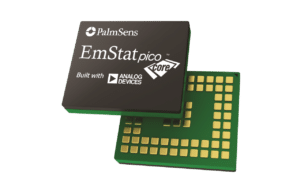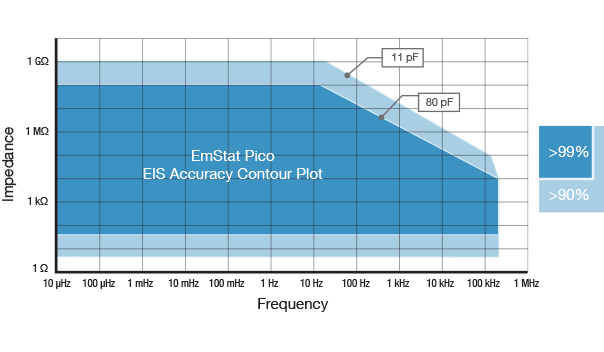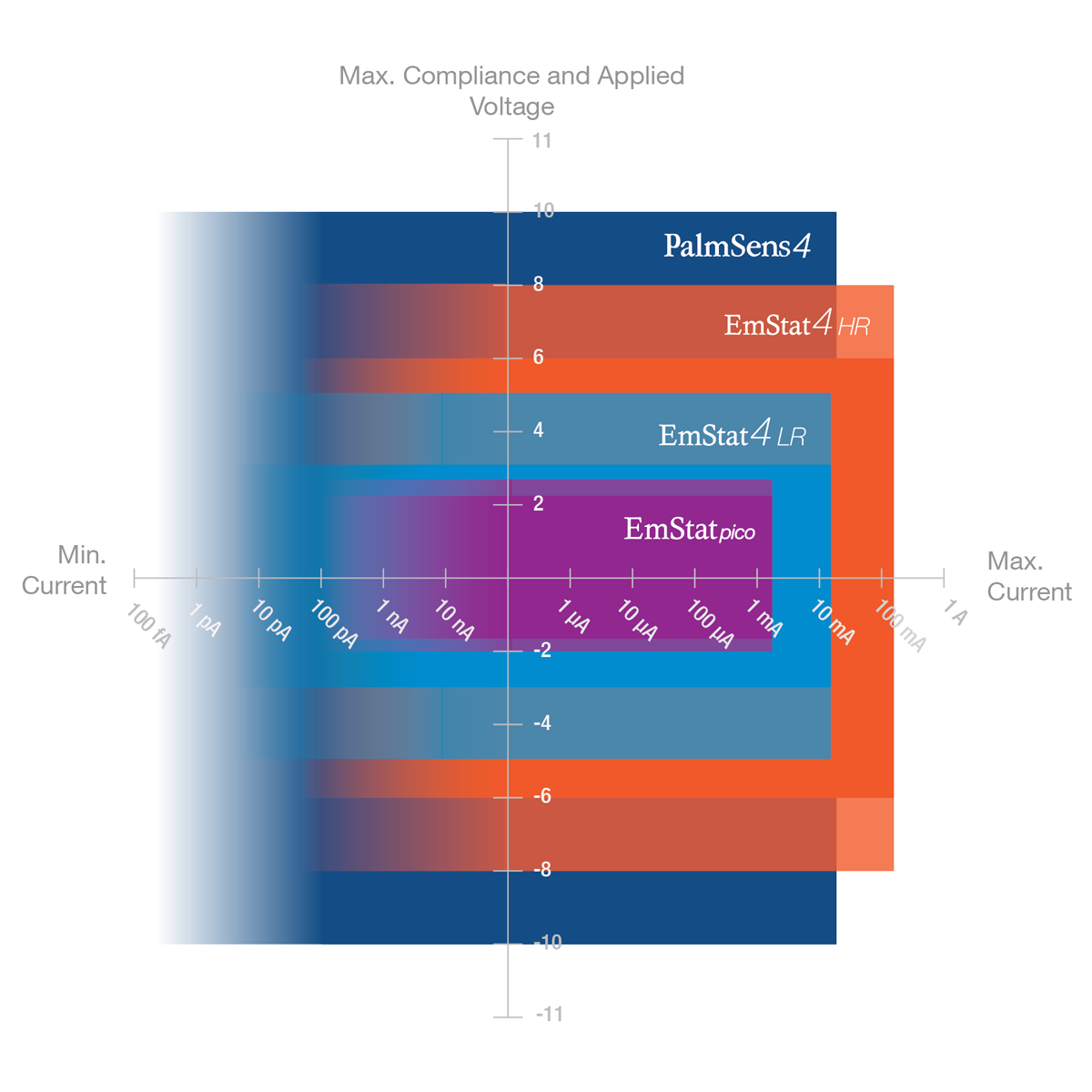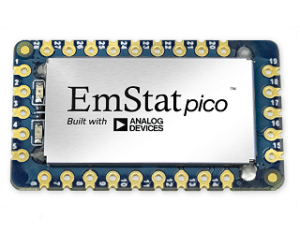EmStat Pico Core
Proven and validated dual-channel potentiostat chip
- Attractive for high-volume applications
- Small footprint of 5 x 6 mm
- Works with MethodSCRIPT
- PalmSens reference design for easy integration
- Support from Analog Devices & PalmSens
Available in batches of 10 000 units
Description
The EmStat Pico Core is a high-volume potentiostat chip for use with MethodSCRIPT™ that enables you to perform electrochemical measurements using your own electrochemical sensor without programming skills. You can integrate this small dual-channel chip of 6 by 5 mm on your PCB without any technical knowledge of potentiostats thanks to the joint development by Analog Devices Inc and PalmSens. Our reference design, network, experience and support will help you succeed and save development time with the smallest potentiostat chip on the market.

- Dimensions: 5 x 6 mm
- Dual channel (2x WE, 2x RE, 2x CE)
- EIS frequency range: 0.016 Hz to 200 kHz
- Full dc-potential range: -1.7 V to +2 V
- Current ranges: 100 nA to 5 mA
- Four different versions available, each with different electrochemical techniques.
Prototype the features of the EmStat Pico Core easily using the EmStat Pico Module and the Development Kit, since the firmware of the EmStat Pico Core is exactly the same as the EmStat Pico Module. The firmware includes proven internal calibration modules for onboard calibration. A host microcontroller is not required in many cases, saving an additional microcontroller. The power consumption during hibernation of 10 µA enables low-power (wearable) applications. The robust UART bootloader enables firmware updates in the field if needed. The open-source parsing examples and libraries on GitHub will quickly get a programmer started in C, C#, Python and Android.
Advantages and Overview
The EmStat Pico Core is at the heart of the EmStat Pico Module. There are two main advantages of the EmStat Pico Core, compared with the EmStat Pico module:
- Economical solution for high volumes
- Small footprint
The EmStat Pico Core is an attractive option if you need >10k units. Lower quantities are available for prototyping. The EmStat Pico Core is distributed via PalmSens and ![]() .
.
|
Pico vs Pico Core |
EmStat Pico |
EmStat Pico Core |
|
Based on ADuCM355 |
|
|
|
Works with MethodSCRIPT |
|
|
|
Minimum Order Quantity |
1 |
10 000 |
|
Footprint |
18 x 30 mm |
6 x 5 mm |
|
1TΩ Input impedance |
|
Optional |
|
Extra 100 nA current range |
|
Optional |
|
Calibration of external TIA resistors |
|
Optional |
The optional items depend on the implementation of the PalmSens reference design.
Specifications
The EmStat Pico Core works at three different modes;
Low Speed mode: for scan rates up to 1 V/s or a bandwidth of 100 Hz.
High Speed mode: for high scan rates and frequencies.
Max Range mode: a combination of the Low and High Speed modes for optimal dynamic dc-potential range.
| General | |||
|---|---|---|---|
| Low Speed mode | High Speed mode | Max Range mode | |
| Full dc-potential range
The maximum potential difference, that can be applied between WE and RE.
|
-1.2 to +2 V | -1.7 to +2 V | -1.7 to +2 V |
| Dynamic dc-potential range [1]
The maximum potential difference, that can be applied between WE and RE.
|
2.2 V | 1.2 V | 2.6 V |
Compliance voltage
The compliance voltage is the maximum voltage that can be applied between the working and counter electrode. Another name could be the maximum cell potential. Continue reading
|
-2.0 to +2.3 V [2] | ||
| Maximum current | ± 3 mA | ||
| Max. acquisition rate (datapoints/s) |
100 | 1000 | 100 |
| Supports FRA/EIS | NO | YES | NO |
[1] The dynamic range is the range that can be covered during a single scan within the full potential range. For example; a linear scan can start at -1.5 V and end at 1.1 V or vice versa, covering 2.6 V dynamic range.
[2] The compliance voltage is the maximum potential between Working and Counter electrode and depends on the selected mode.
[3] If your main WE1 is scanning from -0.5V to +0.5V, the WE2 can only have a maximum offset of 0.6V.
| Dual-channel and Bipotentiostat functionality |
|---|
|
| Potentiostat (controlled potential mode) | |||
|---|---|---|---|
| Channels | 2 (2x WE, 2x RE and 2x CE) | ||
Applied dc-potential resolution
The lowest observable difference between two values that a measurement device can differentiate between.
|
537 µV | 395 µV | 932 µV |
Applied potential accuracy
The applied potential accuracy describes how close to the real values your applied potential is.
|
< 0.2% | < 0.5% | < 0.5% |
Current ranges
A current range defines the maximum current a potentiostat can measure in a certain range. Continue reading
|
100 nA, 2 uA, 4 uA, 8 uA, 16 uA, 32 uA, 63 uA, 125 uA, 250 uA, 500 uA, 1 mA, 5 mA |
100 nA, 1 uA, 6 uA, 13 uA, 25 uA, 50 uA, 100 uA, 200 uA, 1 mA, 5 mA |
100 nA, 1 uA, 6 uA, 13 uA, 25 uA, 50 uA, 100 uA, 200 uA, 1 mA, 5 mA |
Current accuracy
The current accuracy describes how close to the real values your measured current is. Continue reading
|
< 0.5 % of current ±0.1% of range | < 1 % of current ±0.1% of range | |
Measured current resolution
The lowest observable difference between two values that a measurement device can differentiate between. Continue reading
|
0.006% of selected current range (5.5 pA on 100 nA range) |
||
| Measured potential resolution (for OCP) | 56 uV | ||
| FRA / EIS (impedance measurements) | |
|---|---|
| Frequency range | 0.016 Hz to 200 kHz |
| Ac-amplitude range | 1 mV to 0.25 V rms, or 0.708 V p-p |
| Bipotentiostat | |
|---|---|
| Modes | 1. WE2 at fixed potential (E offset vs RE1) 2. WE2 scanning (E offset vs WE1) |
| Max. potential WE2 | ΔE(WE1) + ΔE(WE2) < 1.6 V [3] |
| Electrometer | |
|---|---|
Electrometer amplifier input
The amplifier input resistance of the amplifier in the electrometer determines the load that the amplifier places on the source of the signal being fed into it. Ideally the resistance is infinite, and the load to be zero to not to influence your measurement.
|
> 1 TΩ // 10 pF |
Bandwidth
Bandwidth defines the range of frequencies a system can accurately measure or respond to. Continue reading
|
250 kHz |
| Other | |
|---|---|
| Power Consumption |
Hibernate: 10 μA Active: 5 mA to 15 mA (depending on activity) |
| Storage | 4000 datapoints on-chip (supports optional external SD card or NAND chip for mass storage) |
| Mounting | 72-lead LGA package |
| Dimensions | 6 mm X 5 mm |
| Operation temperature range | -40°C to +85°C |
| EIS Accuracy Contour Plot |
|---|
 |
Software Development
Develop software for PC, smartphone or microcontroller
Whether you want to write a simple or advanced Windows application, develop an Android or iPhone app or integrate the EmStat Pico in your own hardware, you can do it with our software development tools and code examples.
The EmStat Pico Development Board can also be controlled directly with our PSTrace software for Windows and PStouch app for Android.

Software Development Kits for .NET
The PalmSens Software Development Kits (SDKs) for .NET can be used with any of our instruments or OEM potentiostat modules to develop your own software. The SDK’s come with a set of examples that shows how to use the libraries.
PalmSens SDKs with examples are available for the following .NET Frameworks:
- WinForms
- WPF
- Xamarin (for Android)
- UWP

MethodSCRIPT™ communications protocol
The EmStat Pico potentiostat module has an on-board parser for the MethodSCRIPT™ scripting language. This language allows developers to program a human-readable script for the EmStat Pico module on any platform or operating system. The simple script language allows for running electrochemical techniques supported by EmStat Pico and makes it easy to combine different measurements and other tasks.

Downloads
Documentation (13)
| Name | Last updated | |
|---|---|---|
| MethodSCRIPT v1.8 The MethodSCRIPT scripting language is designed to improve the flexibility of the PalmSens potentiostat and galvanostat devices for OEM users. It allows users to start measurements with arguments that are similar to the arguments in PSTrace. PalmSens provides libraries and examples for handling low level communication and generating scripts for MethodSCRIPT devices such as the EmStat Pico and EmStat4. | 16-10-25 | |
| EmStat Pico communication protocol v1.6 This document describes the “online” communication protocol of the EmStat Pico. Initial communication with an EmStat Pico is always done using this online communication. Measurements and other scripts can be started by sending a MethodSCRIPT, | 13-10-25 | |
| EmStat Pico OEM risk considerations Creating a medical or high risk application? Please read these OEM risk considerations to help you implement the EmStat Pico in a safe way. | 11-07-25 | |
| EmStat Pico communication protocol v1.5 This document describes the “online” communication protocol of the EmStat Pico. Initial communication with an EmStat Pico is always done using this online communication. Measurements and other scripts can be started by sending a MethodSCRIPT, | 26-03-25 | |
| MethodSCRIPT v1.7 The MethodSCRIPT scripting language is designed to improve the flexibility of the PalmSens potentiostat and galvanostat devices for OEM users. It allows users to start measurements with arguments that are similar to the arguments in PSTrace. PalmSens provides libraries and examples for handling low level communication and generating scripts for MethodSCRIPT devices such as the EmStat Pico and EmStat4. | 26-03-25 | |
| MethodSCRIPT v1.5 The MethodSCRIPT scripting language is designed to improve the flexibility of the PalmSens potentiostat and galvanostat devices for OEM users. It allows users to start measurements with arguments that are similar to the arguments in PSTrace. PalmSens provides libraries and examples for handling low level communication and generating scripts for MethodSCRIPT devices such as the EmStat Pico and EmStat4. | 25-03-24 | |
| EmStat Pico and EmStat4 bootloader commands This document explains how to enter the bootloader of the EmStat Pico or the EmStat4M and update the firmware. | 05-10-23 | |
| MethodSCRIPT v1.4 The MethodSCRIPT scripting language is designed to improve the flexibility of the PalmSens potentiostat and galvanostat devices for OEM users. It allows users to start measurements with arguments that are similar to the arguments in PSTrace. PalmSens provides libraries and examples for handling low level communication and generating scripts for MethodSCRIPT devices such as the EmStat Pico and EmStat4. | 01-02-23 | |
| EmStat Pico Core – Brochure EmStat Pico Core brochure, Development kit, SDK and more. | 12-09-22 | |
| EmStat Pico communication protocol v1.3 This document describes the “online” communication protocol of the EmStat Pico. Initial communication with an EmStat Pico is always done using this online communication. Measurements and other scripts can be started by sending a MethodSCRIPT, | 13-06-22 | |
| MethodSCRIPT v1.3 The MethodSCRIPT scripting language is designed to improve the flexibility of the PalmSens potentiostat and galvanostat devices for OEM users. It allows users to start measurements with arguments that are similar to the arguments in PSTrace. PalmSens provides libraries and examples for handling low level communication and generating scripts for MethodSCRIPT devices such as the EmStat Pico and EmStat4. | 19-01-22 | |
| MethodSCRIPT v1.2 MethodSCRIPT v1.2 protocol description | 28-04-20 | |
| EmStat Pico communication protocol v1.2 Describes the EmStat Pico communications protocol which is based on MethodSCRIPT | 08-04-20 |
Software (10)
| Name | Last updated | |
|---|---|---|
| EmStat Pico Firmware v1.6 See app note "EmStat Pico firmware updating" for more information about updating built-in and bare EmStat Pico modules. | 13-10-25 | |
| EmStat Pico Firmware v1.5 See app note "EmStat Pico firmware updating" for more information about updating built-in and bare EmStat Pico modules. | 26-03-25 | |
| PSTrace PC software for all single channel instruments PSTrace software is shipped as standard with all single channel and multiplexed instruments. The software provides support for all techniques and device functionalities. | 08-07-24 | |
|
MethodSCRIPT code examples
MethodSCRIPT code examples include:
- MethodSCRIPTExample_C - MethodSCRIPTExample_C_Linux - MethodSCRIPTExample_C# - MethodSCRIPTExample_Arduino - MethodSCRIPTExample_Python - MethodSCRIPTExample_iOS - MethodSCRIPTExample_Android Every code example comes with a "Getting Started" document. |
07-07-24 | |
| PalmSens SDK for Python PalmSens Python SDK 5.12 with support for instruments from PalmSens BV on Windows systems. | 07-11-22 | |
| EmStat Pico Firmware v1.3.4 See app note "EmStat Pico firmware updating" for more information about updating built-in and bare EmStat Pico modules. | 13-12-21 | |
| EmStat Pico Firmware v1.2 See app note "EmStat Pico firmware updating" for more information about updating built-in and bare EmStat Pico modules. | 13-12-21 | |
| Getting started with PalmSens SDK for WPF This manual explains how to use the SDK with the included libraries and examples. | 07-06-21 | |
| Getting started with PalmSens SDK for WinForms This manual explains how to use the SDK with the included libraries and examples. | 07-06-21 | |
| Getting started with PalmSens SDK for Android This manual explains how to use the SDK with the included libraries and examples. | 07-06-21 |
Other (1)
| Name | Last updated | |
|---|---|---|
| Introduction to electrochemical sensing – Tutorial The first part of this presentation contains how electrochemistry works and how it can be used for sensing applications. The second half explains what a potentiostat is and which applications are suitable for the EmStat Pico potentiostat offered by PalmSens. Details of the EmStat Pico’s capabilities will be shown, as well as instructions on how to use it. | 15-07-21 |
Application Note (2)
| Name | Last updated | |
|---|---|---|
| Limitations for EIS on EmStat Pico | 18-12-20 | |
| pH Measurement using EmStat Pico This article shows the ease of integration of the device into a system and demonstrates the range of applications of the potentiostat module by detailing three different electrochemical measurements: OCP (pH), cyclic voltammetry, and EIS. | 07-09-20 |

























